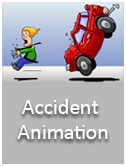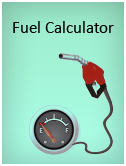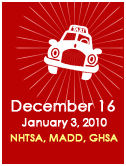Construction Zone Signs - Speed Fines Signs
Municipal Advisory:
Construction Zone Changes - Bill 169
New rules governing speed limits in designated construction zones and the doubling of speeding fines in a construction zone when there are workers present came into effect March 31, 2006. These amendments are part of Bill 169, the Transportation Statute Law Amendment Act, 2005, which received Royal Assent on November 21, 2005.
With the Bill 169 amendments, municipalities in Ontario will obtain new power under the Highway Traffic Act (HTA) to designate construction zones on roads in their jurisdiction. This legislation will improve the safety of both workers and motorists by doubling the HTA fines for speeding in a designated construction zone when there are workers present and by making it easier for municipalities to reduce the enforceable speed limits in construction zones. Bill 169 also makes it an offence to disobey a traffic control person's STOP and SLOW sign.
Construction Zone Speed Limits
Lowering the speed limit in construction zones reduces the risk of collision. Under the new legislation, municipalities have the option of reducing speed limits in construction zones without passing a by-law. The municipal council simply delegates the authority to designate a construction zone, and with that the authority to set the speed limit to a senior staff member who ensures that records are kept detailing when a construction zone speed is changed. The reduced speed limit becomes effective once the required signs are posted.
The Act requires that a construction zone must be clearly marked with standard "CONSTRUCTION ZONE BEGINS" and "CONSTRUCTION ZONE ENDS" signs found in Regulation 615 of the HTA and in the Ontario Traffic Manual Book 7. The reduced speed limit becomes effective once the required signs are posted.
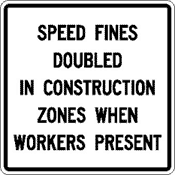
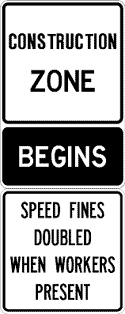
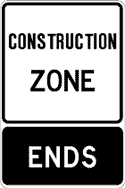
Increased Speed Fines
Increasing fines is an effective way to discourage motorists from speeding. The legislation doubles the normal HTA fines for motorists exceeding the speed limit in a designated construction zone when there are workers present at the site and the prescribed signs are used.
The current practice for speed zone signing in a construction zone is shown in Ontario Traffic Manual Book 7 Temporary Conditions. The speed limit signs would be posted as per Figure TL-3 or TL-4 using regulatory black and white speed limit signs.
To advise motorists of the doubled speed fines, information signs are recommended but not required under the legislation for the double fines to be in effect.
Examples of the Doubling of Fines for Speeding in Construction Zones
- The previous HTA fine for exceeding the speed limit by 20 km/h was $4.50 per km/h over the speed limit and 3 demerit points. With the Bill 169 amendment, the fine for exceeding the posted speed limit in a construction zone where workers are present is doubled to $9.00 per km/h (demerit points remain at 3).
- Also under Bill 169, the HTA fines for traveling 30 to 34 km/h over the speed limit have increased from the previous $4.50 per km/h to $7.00 per km/h and 4 demerit points. When this new amount is doubled it increases to $14.00 per km/h over the limit (demerit points remain at 4).
Disobeying a Traffic Control Person's STOP and SLOW Sign
Effective March 31, 2006, Bill 169 also amended the HTA to make it an offence to disobey a traffic control person's STOP and SLOW sign, incurring fines between $60 and $500 and penalties of 3 demerit points for this offence.
A traffic control person is defined as an individual who directs traffic and works for or is under contract to, a road authority or a utility. Firefighters have also been given the authority to use the traffic control STOP and SLOW sign under Bill 169, therefore fines and penalties would also apply at an accident location where the signs are being used by firefighters.
In some instances, a traffic control person not employed or under contract to a road authority or utility might be required to control traffic on a municipal roadway. In these cases written permission or a permit from the municipality with jurisdiction over the work area must be obtained.
Regulatory Amendments
STOP Sign Placement
In response to requests by municipal organizations including OGRA, the prescribed distance for a STOP sign to be placed from the edge of a roadway for urban and non-urban areas has been amended in Regulation 615. Previously, these distances differed depending on whether the area was urban or rural. However, due to municipal amalgamations the city, town or village status does not always differentiate if there will be urban or rural intersections or a combination of both types. This amendment allows a municipality to follow the Ontario Traffic Manual and post STOP signs related to the configuration of the intersection (urban or rural) and not its municipal status.
Section 8 of HTA Regulation 615 is revoked and the following substituted:
- A stop sign shall be erected so that the left edge of the sign shall be not more than 4 metres from the edge of the roadway.
School Crossing Guard STOP sign
The School Crossing Guard STOP signs were allowed to have a flashing light positioned above the word "STOP" but several signs were manufactured with a flashing light below the word "STOP". The visibility of the two versions of the sign is equal and the ministry has no safety concern with the placement of the light either above or below the word "STOP".
Subsection 11(3) of HTA Regulation 615 is amended by adding "or below" after "above" to allow placement of the optional flashing red light on a school guard's STOP sign to be placed above or below the word "STOP".





